Strengths and Challenges of Using iNaturalist in Plant Research with Focus on Data Quality
Abstract
1. Introduction
2. What iNaturalist Is
3. Strengths of iNaturalist: Potentials and New Opportunities for Plant Research
3.1. Low Technical Requirements, Usability and Immediacy
3.2. Open Access
3.3. Assisted Taxonomic Identification and Quality Check
3.4. Encouragement of the Interaction between Users and Versatility
4. Potential of iNaturalist for Distributional, Taxonomic, Conservation and Biodiversity Management Studies: Some Relevant Examples
| Taxon | Region/Country | Reference and/or iNaturalist Link |
|---|---|---|
| INCREASE IN RECORDS OF NATIVE, ENDEMIC OR THREATENED SPECIES | ||
| Telesonix jamesii (Torr.) Raf. (Saxifragaceae) | Increase in number of records in the United States of America | [27] |
| Lupinus aureonitens Gillies ex Hook. & Arn. (Fabaceae) | New localities in Argentina | [28] |
| Tiputinia foetida P.E. Berry & C.L. Woodw. (Thismiaceae) | First record in Peru | https://www.inaturalist.org/observations/40905049; https://www.inaturalist.org/blog/32964-this-plant-was-found-hundreds-of-kilometers-from-its-known-range-observation-of-the-week-4-12-20 (accessed on 15 April 2023) |
| Eucrosia stricklandii (Baker) Meerow var. stricklandii Amaryllidaceae) | New locality in Ecuador | https://www.inaturalist.org/observations/93785060 (accessed on 15 April 2023) |
| Gasteranthus extinctus L.E. Skog & L.P. Kvist (Gesneriaceae) | Rediscovery of a presumed extinct species in Ecuador | [29]; https://www.inaturalist.org/observations/36478271; https://www.inaturalist.org/observations/36473651; https://www.inaturalist.org/observations/36415279 (accessed on 17 November 2023) |
| DISCOVERY OF NEW PLANT SPECIES | ||
| Gonolobus naturalistae M.G. Chávez, Pío-León & L.O. Alvarado (Apocynaceae) | New species described for Mexico | [30]; https://www.inaturalist.org/observations/4447993 (accessed on 10 February 2023) |
| Lomandra briggsiana R.L. Barrett & T.C. Wilson (Asparagaceae) | New species described for Australia | [33]; https://inaturalist.ala.org.au/observations/59760073 (accessed on 17 November 2023) |
| Thismia paradisiaca S. Guzm.-Guzm. (Thismiaceae) | New species described for Colombia | [32]; https://www.inaturalist.org/observations/10252116; https://www.inaturalist.org/observations/81910064 (accessed on 17 November 2023) |
| Aphyllon chiapense Franc. Gut. & L.O. Alvarado (Orobanchaceae) | New species described for Mexico | [31]; https://www.naturalista.mx/observations/10776255; https://www.naturalista.mx/observations/145552685; https://www.naturalista.mx/observations/146226689 (accessed on 17 November 2023) |
| NEW RECORDS AND MONITORING OF ALIEN PLANTS | ||
| Actinidia chinensis Planch. var. deliciosa (A. Chev.) A. Chev. (Actinidiaceae), Astrantia major L. (Apiaceae), Berberis congestiflora Gay (Berberidaceae), Eryngium planum L. (Apiaceae) and Epilobium hirsutum L. (Onagraceae) | First records for New Zealand | [38] |
| Noccaea perfoliata (L.) Al-Shehbaz (Brassicaceae) | First record (and further ones) for Texas (United States of America) | [35] |
| 33 invasive or potentially invasive plant taxa | Detection and monitoring (over a period of 3 years) of populations in Costa Brava (NE Spain) | https://www.inaturalist.org/projects/life-medcliffs-xarxa-de-voluntaris (accessed on 17 November 2023) |
| Kalanchoe (16 species, Crassulaceae) | New records, delimiting ranges and monitoring of taxa expansion in Ecuador | [37] |
| Phyllostachys aurea (André) Rivière & C. Rivière (Poaceae) and other bamboo species | New records, delimiting ranges and characterizing populations in NW Italy | [36] |
| Asparagus falcatus L. | First record for Spain | https://www.inaturalist.org/observations/109741140 (accessed on 17 November 2023) |
5. Using iNaturalist in Plant Research: Key Considerations and Recommendations
5.1. Low-Quality Photographs Associated with the Observations
5.2. Errors of Taxonomic Identification
5.3. Lack of Distinction between Captive and Wild Species Observations
5.4. Lack of Accuracy in the Geographic Coordinates
5.5. Duplicated Records
5.6. Taxa Not Accommodable to iNaturalist Plant Taxonomic Reference
6. Recurrent Bad Practice by Users in Bioblitzes: The Experience of the Spanish Biomaratón
7. Conclusions
Author Contributions
Funding
Institutional Review Board Statement
Data Availability Statement
Acknowledgments
Conflicts of Interest
References
- Dickinson, J.L.; Zuckerberg, B.; Bonter, D.N. Citizen science as an ecological research tool: Challenges and benefits. Annu. Rev. Ecol. Evol. Syst. 2010, 41, 149–172. [Google Scholar] [CrossRef]
- Pescott, O.L.; Walker, K.J.; Pocock, M.J.O.; Jitlal, M.; Outhwaite, C.L.; Cheffings, C.M.; Harris, F.; Roy, D.B. Ecological monitoring with citizen science: The design and implementation of schemes for recording plants in Britain and Ireland. Biol. J. Linn. Soc. Lond. 2015, 115, 505–521. [Google Scholar] [CrossRef]
- Kobori, H.; Dickinson, J.L.; Washitani, I.; Sakurai, R.; Amano, T.; Komatsu, N.; Kitamura, W.; Takagawa, S.; Koyama, K.; Ogawara, T.; et al. Citizen science: A new approach to advance ecology, education, and conservation. Ecol. Res. 2016, 31, 1–19. [Google Scholar] [CrossRef]
- Silvertown, J. A new dawn for citizen science. Trends Ecol. Evol. 2009, 24, 467–471. [Google Scholar] [CrossRef] [PubMed]
- Farber, P.L. The development of ornithological collections in the late eighteenth and early nineteenth centuries and their relationship to the emergence of ornithology as a scientific discipline. J. Soc. Bibliogr. Nat. Hist. 1980, 9, 391–394. [Google Scholar] [CrossRef]
- Keeney, E. The Botanizers: Amateur Scientists in Nineteenth-Century America; The University of North Carolina Press: Chapel Hill, NC, USA; London, UK, 1992. [Google Scholar]
- Miller-Rushing, A.; Primack, R.; Bonney, R. The history of public participation in ecological research. Front. Ecol. Environ. 2012, 10, 285–290. [Google Scholar] [CrossRef]
- Pocock, M.J.O.; Tweddle, J.C.; Savage, J.; Robinson, L.D.; Roy, H.E. The diversity and evolution of ecological and environmental citizen science. PLoS ONE 2017, 12, e0172579. [Google Scholar] [CrossRef]
- Lundmark, C. BioBlitz: Getting into backyard biodiversity. BioScience 2003, 53, 329. [Google Scholar] [CrossRef]
- Aristeidou, M.; Herodotou, C.; Ballard, H.L.; Young, A.N.; Miller, A.E.; Higgins, L.; Johnson, R.F. Exploring the participation of young citizen scientists in scientific research: The case of iNaturalist. PLoS ONE 2021, 16, e0245682. [Google Scholar] [CrossRef]
- Márquez-Corro, J.I.; Jiménez Mejías, P.; Fernández-Mazuecos, M.; Ramos-Gutiérrez, I.; Martín-Herranz, S.; Martín-Bravo, S.; Alfaro-Saiz, E.; Blanco-Salas, J.; Borras, J.; Capó, M.; et al. I Biomaratón de Flora Española: Ciencia ciudadana para visibilizar la biodiversidad vegetal. Conserv. Veg. 2021, 25, 33–37. [Google Scholar]
- Morzy, M. ICT Services for open and citizen science. World Wide Web 2015, 18, 1147–1161. [Google Scholar] [CrossRef][Green Version]
- Kress, W.J.; Garcia-Robledo, C.; Soares, J.V.B.; Jacobs, D.; Wilson, K.; Lopez, I.C.; Belhumeur, P.N. Citizen science and climate change: Mapping the range expansions of native and exotic plants with the mobile app Leafsnap. BioScience 2018, 68, 348–358. [Google Scholar] [CrossRef]
- Echeverria, A.; Ariz, I.; Moreno, J.; Peralta, J.; Gonzalez, E.M. Learning plant biodiversity in nature: The use of the citizen–science platform iNaturalist as a collaborative tool in secondary education. Sustainability 2021, 13, 735. [Google Scholar] [CrossRef]
- Haklay, M. Citizen science and volunteered geographic information: Overview and typology of participation. In Crowdsourcing Geographic Knowledge; Sui, D., Elwood, S., Goodchild, M., Eds.; Springer: Dordrecht, The Netherlands, 2013; pp. 105–122. [Google Scholar] [CrossRef]
- Marcenò, C.; Padullés Cubino, J.; Chytrý, M.; Genduso, E.; Gristina, A.S.; La Rosa, A.; Salemi, D.; Landucci, F.; Pasta, S.; Guarino, R. Plant hunting: Exploring the behavior of amateur botanists in the field. Biodivers. Conserv. 2021, 30, 3265–3278. [Google Scholar] [CrossRef]
- Crisci, J.V.; Katinas, L.; Apodaca, M.J.; Hoch, P.C. The end of botany. Trends Plant Sci. 2020, 25, 1173–1176. [Google Scholar] [CrossRef] [PubMed]
- Löbl, I.; Klausnitzer, B.; Hartmann, M.; Krell, F.-T. The silent extinction of species and taxonomists—An appeal to science policymakers and legislators. Diversity 2023, 15, 1053. [Google Scholar] [CrossRef]
- Fontaine, B.; van Achterberg, K.; Alonso-Zarazaga, M.A.; Araujo, R.; Asche, M.; Aspöck, H.; Aspöck, U.; Audisio, P.; Aukema, B.; Bailly, N.; et al. New species in the Old World: Europe as a frontier in biodiversity exploration, a test bed for 21st century taxonomy. PLoS ONE 2012, 7, e36881. [Google Scholar] [CrossRef]
- Waller, J. Will Citizen Science Take Over? Available online: https://data-blog.gbif.org/post/gbif-citizen-science-data/ (accessed on 24 March 2023).
- Otegui, J.; Ariño, A.H.; Encinas, M.A.; Pando, F. Assessing the primary data hosted by the Spanish node of the Global Biodiversity Information Facility (GBIF). PLoS ONE 2013, 8, e55144. [Google Scholar] [CrossRef]
- Contreras-Díaz, R.; Nori, J.; Chiappa-Carrara, X.; Peterson, A.; Soberón, J.; Osorio-Olvera, L. Well-intentioned initiatives hinder understanding biodiversity conservation: Cloaked iNaturalist information for threatened species. Biol. Conserv. 2023, 282, 110042. [Google Scholar] [CrossRef]
- Van Horn, G.; Mac Aodha, O.; Song, Y.; Cui, Y.; Sun, C.; Shepard, A.; Adam, H.; Perona, P.; Belongie, S. The iNaturalist species classification and detection dataset. In Proceedings of the 2018 IEEE/CVF Conference on Computer Vision and Pattern Recognition, Salt Lake City, UT, USA, 18–23 June 2018; pp. 8769–8778. [Google Scholar] [CrossRef]
- Unger, S.; Rollins, M.; Tietz, A.; Dumais, H. iNaturalist as an engaging tool for identifying organisms in outdoor activities. J. Biol. Educ. 2021, 55, 537–547. [Google Scholar] [CrossRef]
- Martínez-Sagarra, G.; Castilla, F.; Pando, F. Seven hundred projects in iNaturalist Spain: Performance and lessons learned. Sustainability 2022, 14, 11093. [Google Scholar] [CrossRef]
- Villarino, T.; Mairal, M. Proyecto SICAF: Implementando una herramienta para la conservación de la flora vascular española amenazada mediante ciencia ciudadana. Conserv. Veg. 2021, 25, 38–41. [Google Scholar]
- Gaier, A.G.; Resasco, J. Does adding community science observations to museum records improve distribution modeling of a rare endemic plant? Ecosphere 2023, 14, e4419. [Google Scholar] [CrossRef]
- Guerrero, E.L. Distribución geográfica histórica y actual y estado de conservación del lupino pampeano Lupinus aureonitens (Fabaceae). Bol. Soc. Argent. Bot. 2023, 58, 243–256. [Google Scholar] [CrossRef]
- Pitman, N.C.A.; White, D.M.; Guevara Andino, J.E.; Couvreur, T.L.P.; Fortier, R.P.; Zapata, J.N.; Cornejo, X.; Clark, J.L.; Feeley, K.J.; Johnston, M.K.; et al. Rediscovery of Gasteranthus extinctus LE Skog & LP Kvist (Gesneriaceae) at multiple sites in western Ecuador. PhytoKeys 2022, 194, 33–46. [Google Scholar] [CrossRef] [PubMed]
- Alvarado-Cárdenas, L.O.; Chávez-Hernández, M.G.; Pío León, J.F. Gonolobus naturalistae (Apocynaceae; Asclepiadoideae; Gonolobeae; Gonolobinae), a new species from México. Phytotaxa 2020, 472, 249–258. [Google Scholar] [CrossRef]
- Francisco-Gutiérrez, A.; Alvarado-Cárdenas, L.O. A new tropical species of Aphyllon (Orobanchaceae: Orobancheae) from Chiapas, Mexico. Bot. Sci. 2023, 101, 1174–1183. [Google Scholar] [CrossRef]
- Guzmán-Guzmán, S.; Plata-Torres, A. A flower in paradise: Citizen science helps to discover Thismia paradisiaca (Thismiaceae), a new species from the Chocó Biogeographic region in Colombia. Phytotaxa 2023, 603, 27–42. [Google Scholar] [CrossRef]
- Barrett, R.L.; Wilson, T.C. Bush Blitz collections and iNaturalist observations assist the recognition of a new species from New South Wales, Lomandra briggsiana (Asparagaceae). Telopea 2023, 26, 133–143. [Google Scholar] [CrossRef]
- Naive, M.A.; Reagan, J.; Wongso, S.; Jacobsen, N. Cryptocoryne esquerionii (Araceae), a remarkable new species discovered by a citizen scientist in Zamboanga Peninsula, southwestern Philippines. Nord. J. Bot. 2023, 2023, e03892. [Google Scholar] [CrossRef]
- Neill, A.K.; Kieschnick, S.R. Noccaea perfoliata or Microthlaspi perfoliatum (Brassicaceae), new to the flora of Texas, USA. J. Bot. Res. Inst. Tex. 2021, 15, 309–315. [Google Scholar] [CrossRef]
- Pittarello, M.; Ravetto Enri, S.; Nota, G.; Lombardi, G.; Mezzasalma, V.; Frigerio, J.; Lonati, M. BambApp: A citizen science project for the re-evaluation of the invasive potential of bamboo species in North-West Italy. Acta Hortic. 2021, 1331, 269–276. [Google Scholar] [CrossRef]
- Vargas, A.; Herrera, I.; Nualart, N.; Guézou, A.; Gómez-Bellver, C.; Freire, E.; Jaramillo Díaz, P.; López-Pujol, J. The Genus Kalanchoe (Crassulaceae) in Ecuador: From gardens to the wild. Plants 2022, 11, 1746. [Google Scholar] [CrossRef] [PubMed]
- Sullivan, J.J.; Meurk, C.D.; Dawson, M.I.; Hutchison, M.A. Crowdsourcing the discovery of new plant naturalisations in Canterbury using iNaturalist NZ. Canterb. Bot. Soc. J. 2019, 50, 54–66. [Google Scholar]
- Gómez-Bellver, C.; Ibáñez, N.; López-Pujol, J.; Nualart, N.; Susanna, A. How photographs can be a complement of herbarium vouchers: A proposal of standardization. Taxon 2019, 68, 1321–1326. [Google Scholar] [CrossRef]
- Heberling, J.M.; Isaac, B.L. iNaturalist as a tool to expand the research value of museum specimens. Appl. Plant Sci. 2018, 6, e01193. [Google Scholar] [CrossRef] [PubMed]
- McMullin, R.T.; Allen, J.L. An assessment of data accuracy and best practice recommendations for observations of lichens and other taxonomically difficult taxa on iNaturalist. Botany 2022, 100, 491–497. [Google Scholar] [CrossRef]
- Kendal, D.; Dobbs, C.; Gallagher, R.V.; Beaumont, L.J.; Baumann, J.; Williams, N.S.G.; Livesley, S.J. A global comparison of the climatic niches of urban and native tree populations. Glob. Ecol. Biogeogr. 2018, 27, 629–637. [Google Scholar] [CrossRef]
- Ceccarelli, V.; Fremout, T.; Zavaleta, D.; Lastra, S.; Imán Correa, S.; Arévalo-Gardini, E.; Rodriguez, C.A.; Cruz Hilacondo, W.; Thomas, E. Climate change impact on cultivated and wild cacao in Peru and the search of climate change-tolerant genotypes. Divers. Distrib. 2021, 27, 1462–1476. [Google Scholar] [CrossRef]
- van Kleunen, M.; Essl, F.; Pergl, J.; Brundu, G.; Carboni, M.; Dullinger, S.; Early, R.; González-Moreno, P.; Groom, Q.J.; Hulme, P.E.; et al. The changing role of ornamental horticulture in alien plant invasions: Horticulture and plant invasions. Biol. Rev. 2018, 93, 1421–1437. [Google Scholar] [CrossRef]
- Pyšek, P.; Richardson, D.M.; Rejmánek, M.; Webster, G.L.; Williamson, M.; Kirschner, J. Alien plants in checklists and floras: Towards better communication between taxonomists and ecologists. Taxon 2004, 53, 131–143. [Google Scholar] [CrossRef]
- Marchetti, M.P.; Engstrom, T. The conservation paradox of endangered and invasive species. Conserv. Biol. 2016, 30, 434–437. [Google Scholar] [CrossRef] [PubMed]
- Pollock, N.B.; Howe, N.; Irizarry, I.; Lorusso, N.; Kruger, A.; Himmler, K.; Struwe, L. Personal BioBlitz: A new way to encourage biodiversity discovery and knowledge in K–99 education and outreach. BioScience 2015, 65, 1154–1164. [Google Scholar] [CrossRef][Green Version]
- Bacon, C.D.; Baker, W.J.; Simmons, M.P. Miocene dispersal drives island radiations in the palm tribe Trachycarpeae (Arecaceae). Syst. Biol. 2012, 61, 426–442. [Google Scholar] [CrossRef] [PubMed]
- Klimova, A.; Ortega-Rubio, A.; Vendrami, D.L.J.; Hoffman, J.I. Genotyping by sequencing reveals contrasting patterns of population structure, ecologically mediated divergence, and long-distance dispersal in North American palms. Ecol. Evol. 2018, 8, 5873–5890. [Google Scholar] [CrossRef]
- Villanueva-Almanza, L.; Garcillán, P.P.; Ávila-Lovera, E.; Pérez, V.; Silva Bejarano, C.; Focht, E.; Ezcurra, E. A Hollywood palm icon unmasked: Clinal variation in Washingtonia (Arecaceae) of Peninsular California. Bot. J. Linn. Soc. 2018, 188, 406–425. [Google Scholar] [CrossRef]
- Villanueva-Almanza, L.; Landis, J.B.; Koenig, D.; Ezcurra, E. Genetic and morphological differentiation in Washingtonia (Arecaceae): Solving a century-old palm mystery. Bot. J. Linn. Soc. 2021, 196, 506–523. [Google Scholar] [CrossRef]
- Rosa, R.M.; Cavallari, D.C.; Salvador, R.B. iNaturalist as a tool in the study of tropical molluscs. PLoS ONE 2022, 17, e0268048. [Google Scholar] [CrossRef]
- Tedesco, P.A.; Bigorne, R.; Bogan, A.E.; Giam, X.; Jézéquel, C.; Hugueny, B. Estimating how many undescribed species have gone extinct. Conserv. Biol. 2014, 28, 1360–1370. [Google Scholar] [CrossRef]
- Lees, A.C.; Pimm, S.L. Species, extinct before we know them? Curr. Biol. 2015, 25, R177–R180. [Google Scholar] [CrossRef]
- Greene, A.M.; Teixidor-Toneu, I.; Odonne, G. To pick or not to pick: Photographic voucher specimens as an alternative method to botanical collecting in ethnobotany. J. Ethnobiol. 2023, 43, 44–56. [Google Scholar] [CrossRef]
- Mesaglio, T.; Sauquet, H.; Coleman, D.; Wenk, E.; Cornwell, W.K. Photographs as an essential biodiversity resource: Drivers of gaps in the vascular plant photographic record. New Phytol. 2023, 238, 1685–1694. [Google Scholar] [CrossRef]
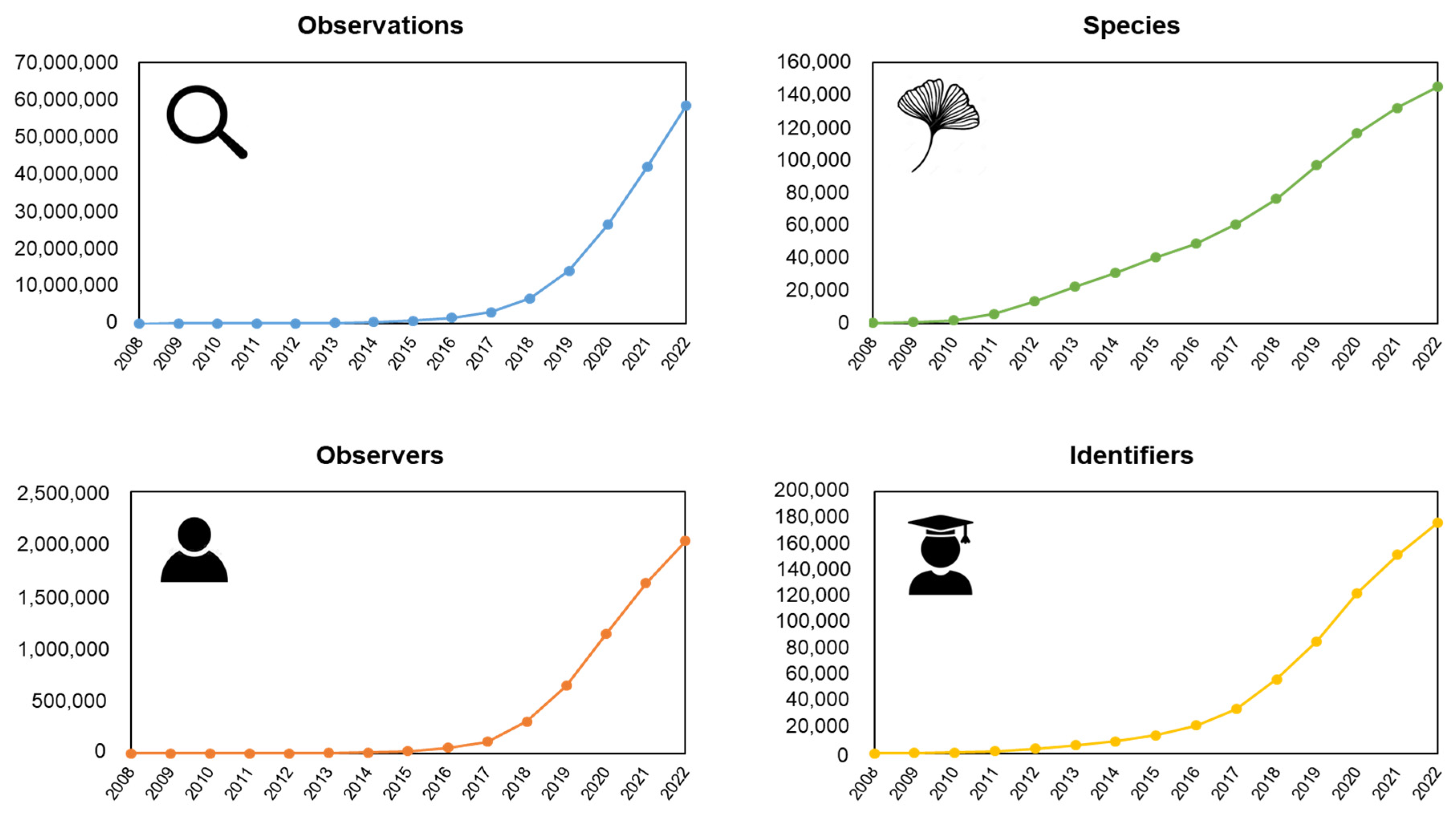
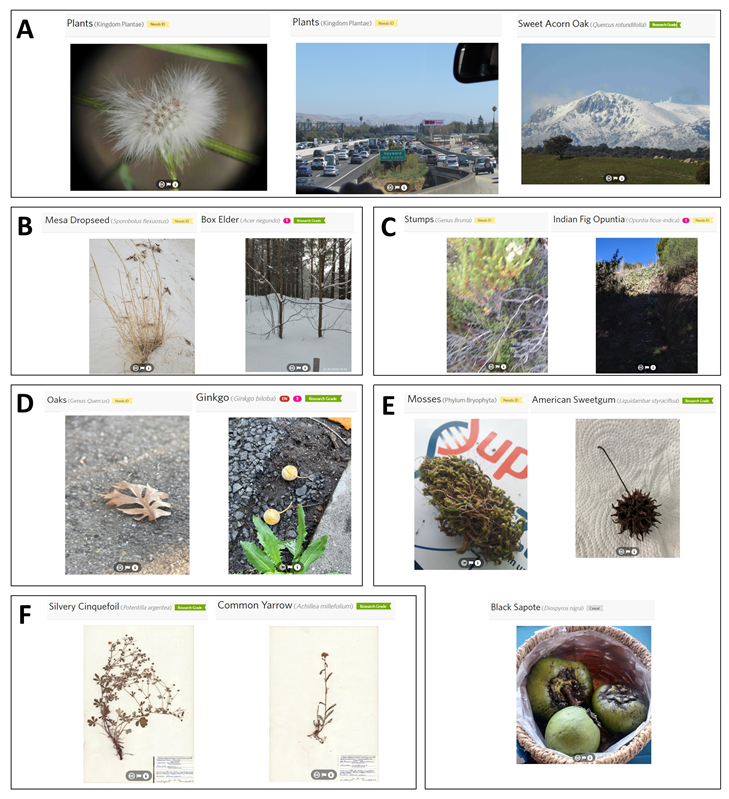

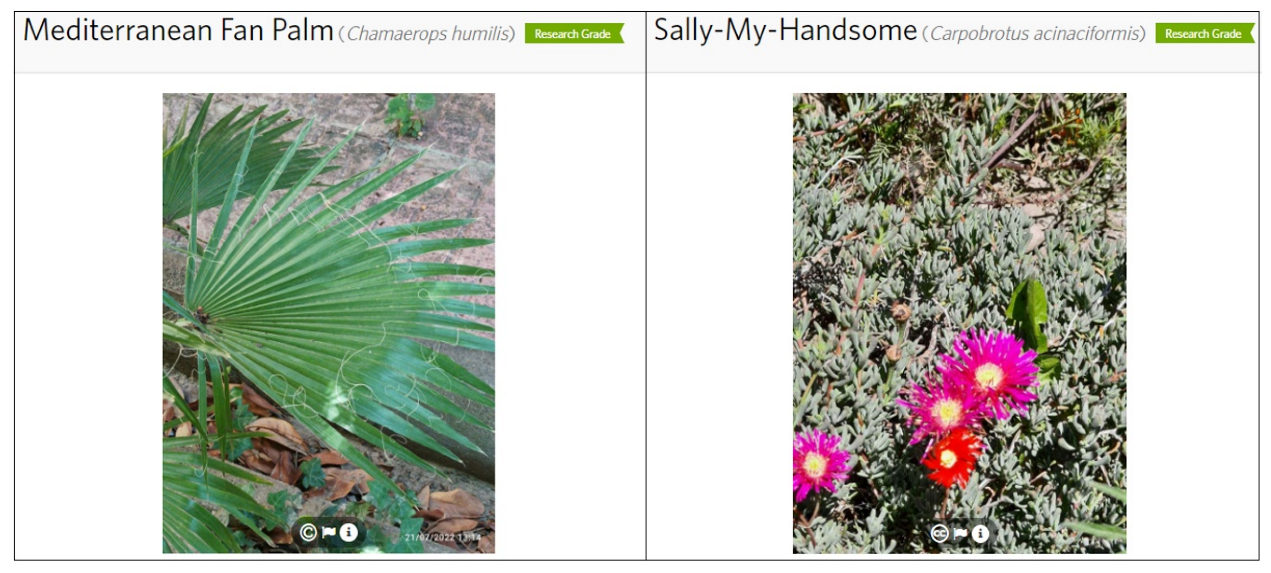

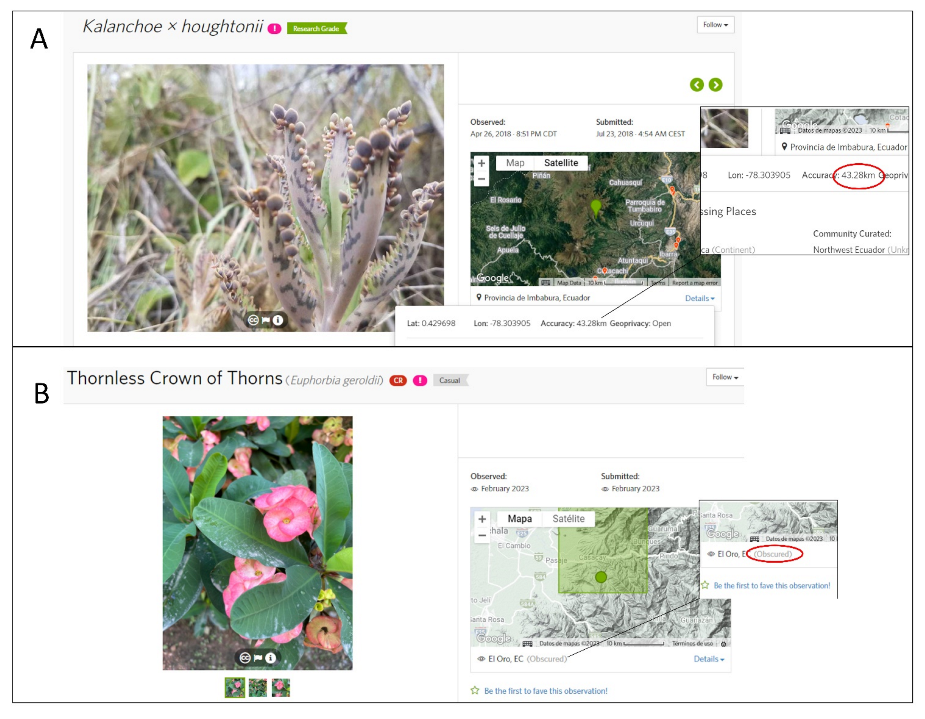
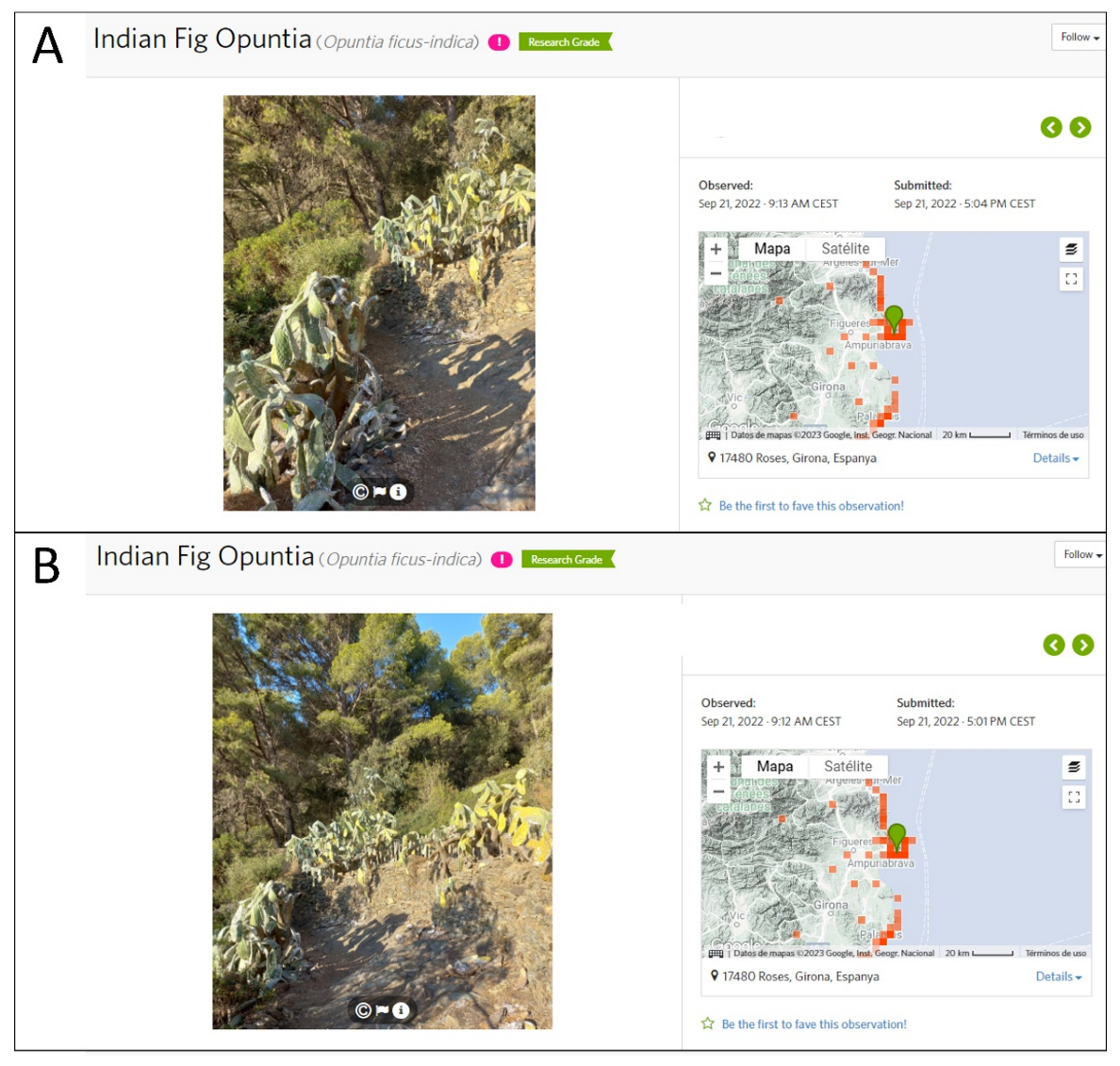
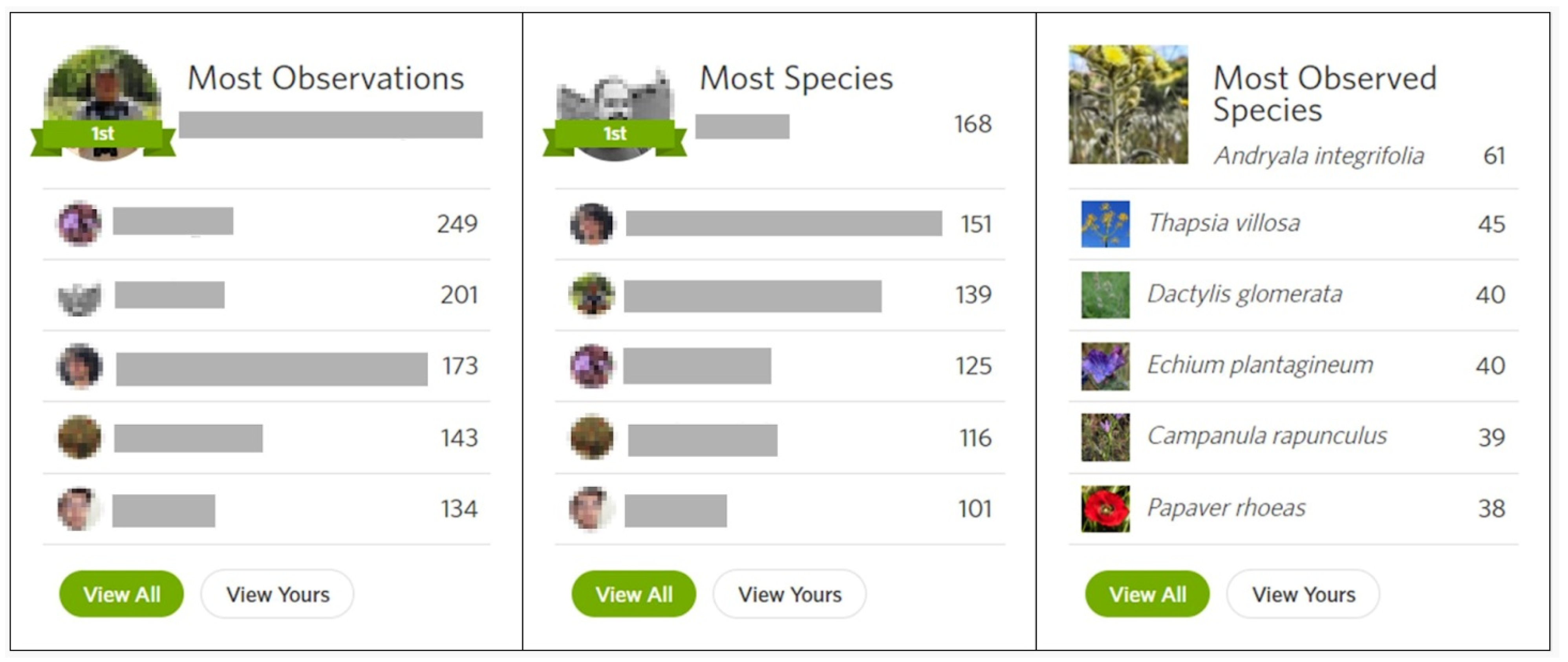
Disclaimer/Publisher’s Note: The statements, opinions and data contained in all publications are solely those of the individual author(s) and contributor(s) and not of MDPI and/or the editor(s). MDPI and/or the editor(s) disclaim responsibility for any injury to people or property resulting from any ideas, methods, instructions or products referred to in the content. |
© 2024 by the authors. Licensee MDPI, Basel, Switzerland. This article is an open access article distributed under the terms and conditions of the Creative Commons Attribution (CC BY) license (https://creativecommons.org/licenses/by/4.0/).
Share and Cite
López-Guillén, E.; Herrera, I.; Bensid, B.; Gómez-Bellver, C.; Ibáñez, N.; Jiménez-Mejías, P.; Mairal, M.; Mena-García, L.; Nualart, N.; Utjés-Mascó, M.; et al. Strengths and Challenges of Using iNaturalist in Plant Research with Focus on Data Quality. Diversity 2024, 16, 42. https://doi.org/10.3390/d16010042
López-Guillén E, Herrera I, Bensid B, Gómez-Bellver C, Ibáñez N, Jiménez-Mejías P, Mairal M, Mena-García L, Nualart N, Utjés-Mascó M, et al. Strengths and Challenges of Using iNaturalist in Plant Research with Focus on Data Quality. Diversity. 2024; 16(1):42. https://doi.org/10.3390/d16010042
Chicago/Turabian StyleLópez-Guillén, Eduard, Ileana Herrera, Badis Bensid, Carlos Gómez-Bellver, Neus Ibáñez, Pedro Jiménez-Mejías, Mario Mairal, Laura Mena-García, Neus Nualart, Mònica Utjés-Mascó, and et al. 2024. "Strengths and Challenges of Using iNaturalist in Plant Research with Focus on Data Quality" Diversity 16, no. 1: 42. https://doi.org/10.3390/d16010042
APA StyleLópez-Guillén, E., Herrera, I., Bensid, B., Gómez-Bellver, C., Ibáñez, N., Jiménez-Mejías, P., Mairal, M., Mena-García, L., Nualart, N., Utjés-Mascó, M., & López-Pujol, J. (2024). Strengths and Challenges of Using iNaturalist in Plant Research with Focus on Data Quality. Diversity, 16(1), 42. https://doi.org/10.3390/d16010042











